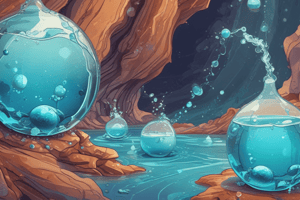Podcast
Questions and Answers
What is the chemical formula of the water molecule?
What is the chemical formula of the water molecule?
H2O
Which of the following describes freshwater?
Which of the following describes freshwater?
- Tasteless, odorless, and colorless (correct)
- Contains less than 1% salt (correct)
- Contains at least 3% salt
- Found in oceans and seas
Saltwater has a lower density than freshwater.
Saltwater has a lower density than freshwater.
False (B)
Match the following salts with their chemical formulas:
Match the following salts with their chemical formulas:
What is the boiling point of water?
What is the boiling point of water?
What is achieved by cooling water in marine engines?
What is achieved by cooling water in marine engines?
Freshwater is found in lakes, streams, rivers, groundwater, ice, and __________.
Freshwater is found in lakes, streams, rivers, groundwater, ice, and __________.
What percentage of salt is typically present in seawater?
What percentage of salt is typically present in seawater?
Study Notes
Water Composition and Properties
- Water is a clear, colorless liquid essential for life, composed of two hydrogen atoms and one oxygen atom (H2O).
- Exists in three phases: ice (crystalline solid, below 0°C), liquid (0 to 100°C), and vapor (above 100°C).
- Acts as a powerful solvent and catalyst in various chemical reactions.
- Boiling point: 100°C (212°F); Freezing point: 0°C (32°F).
Differences Between Freshwater and Saltwater
- Freshwater contains less than 1% salt; often under 0.5%, and is found in lakes, rivers, glaciers, and groundwater.
- Saltwater, with at least 3% salt, is found in oceans and seas and is unsuitable for human consumption.
- Saltwater has higher density than freshwater and supports species like sharks, tuna, and dolphins.
Chemical Analysis of Seawater
- Key dissolved solids in seawater include:
- Sodium chloride (NaCl): 79% (25,000 PPM)
- Magnesium chloride (MgCl2): 10% (3,000 PPM)
- Magnesium sulfate (MgSO4): 6% (2,000 PPM)
- Calcium sulfate (CaSO4): 4% (1,200 PPM)
- Calcium bicarbonate (Ca(HCO3)2): <1% (200 PPM)
Chemical Composition of a Freshwater Sample
- Salt composition includes:
- Sodium chloride (NaCl): 50 PPM
- Sodium nitrate (NaNO3): 35 PPM
- Magnesium sulfate (MgSO4): 30 PPM
- Calcium sulfate (CaSO4): 90 PPM
- Calcium carbonate (CaCO3): 200 PPM
Ions in Seawater
- Major ions in seawater:
- Chloride (Cl-): 55.03%
- Sodium (Na+): 30.59%
- Sulfate (SO4-2): 7.68%
- Magnesium (Mg+2): 3.68%
- Calcium (Ca+2): 1.18%
- Potassium (K+): 1.11%
Marine Engine Cooling Water System
- Vital for large vessels to safely remove excess heat from engines and generators.
- Cooling is achieved by circulating a cooling liquid through engine passages, which absorbs heat.
- Heated liquid is then cooled by seawater to prevent engine failure due to high temperatures.
- Adequate cooling maintains the mechanical properties of engine metals and is key in industrial processes to dissipate large heat amounts.
Studying That Suits You
Use AI to generate personalized quizzes and flashcards to suit your learning preferences.
Description
This quiz explores the physical and chemical properties of cooling water, focusing on water chemistry analyses. It highlights the identification of chemical components and the significance of water's purity in various applications. Perfect for those studying environmental science or chemistry.




